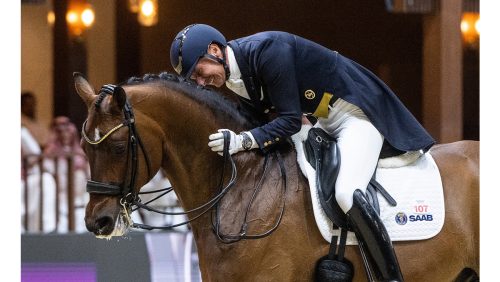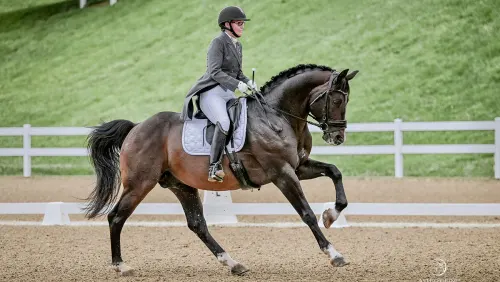West Palm Beach, Fla.—Jan. 28
The group seated on the floor level of the Jim Brandon Equestrian Center at the Global Dressage Forum North America today looked like a veritable who’s who of the dressage world. There was Steffen Peters. There was Klaus Balkenhol, Anne Gribbons, Arthur Kottas, Jan Ebeling, Sue Blinks, Stephen Clarke, Lendon Gray and Michael Poulin, and the list goes on and on. But turning around to look in the stands was even more amazing—there were hundreds of people there, hopeful they’d soon be learning more about the sport. Many of those dressage enthusiasts stayed until the program’s late conclusion at 11:00 p.m.
Event organizer Andreas Stano opened today’s program—the first of two full days of lectures, demonstrations and panels—with a rhetorical question: “Why are you here?” And if your answer was to learn more about riding, training, breeding, farrier work or in-hand training, then you likely left with some fresh information; the day’s agenda was quite varied and thorough. (So thorough that the crowd protested the lengthy question-and-answer sessions at times, eager to get to the riding portions.)
The Monday program started with State Of The Union-type addresses from U.S. Dressage Federation President George Williams and Canadian Olympian Ashley Holzer on each country’s respective programs, and then moved on to a lecture from reproductive veterinarian Dr. Juan Samper. After Dr. Samper discussed potential breeding complications, it was Peters’ turn to speak. Peters, who just finished third in the World Dressage Masters Palm Beach CDI***** with Legolas, took questions from Stano and from the panel of Christoph Hess, Clarke, Gray, Blinks, Williams, Wim Ernes and Gary Rockwell.
Peters told the inspiring story of his now-retired Grand Prix horse, Udon—a horse his family purchased for the equivalent of $2,000 when the horse was 3.
“He was 18 when he did the Olympic Games in 1996, and it was an amazing journey,” said Peters. “My sister and I were the first ones to sit on him, and I was the last one to get off of him.”
But Peters soon moved on from memories of the past to knowledge of the present, and he helped two riders with two different horses. During the question-and-answer session and while teaching, Peters made clear that there’s one attribute he values over any other.
“It’s always about the contact. It’s never, ever not about the contact,” he said. “It’s so easy to just say, ‘My horse has to get stronger down the road,’ but I’m very picky about my horse’s understanding of what the connection is all about. I say, ‘Yes, I love this horse, but for these 45 minutes my horse also becomes my business partner.’ That shows how much mutual respect you have to have.
ADVERTISEMENT
“If the contact is not light and consistent, so many things go wrong. There are so many things that escalate from a contact that’s not well-managed or clearly understood from horse or rider,” Peters continued. “I really think each and every day, ‘Is this the connection I want to take in the show arena? Is this connection manageable?’ It really tells me everything. Is my horse adjustable in the neck length? Is he adjustable in the neck height?”
Peters took that priority to the horses and riders he helped, and he didn’t let the lessons get too complicated beyond that. The first participant—Jami Kment on Zania, a 9-year-old Dutch Warmblood mare—and the second—Marcus Orlob on Et Voila, an 8-year-old Hanoverian—were seated on very different kinds of horses, but the work was similar. Both horses schooled transitions, within and between the gaits, with emphasis always on the quality of the connection. Peters continually stressed that the horse must understand precisely what the rider wants.
“I love to keep it simple and straightforward,” said Peters.
Other tidbits from today’s program:
- Farrier Grant Moon spoke about the proper balance of the hoof. “I don’t expect to teach you how to shoe a dressage horse,” he said. “There’s not one type of shoeing to fit all horses. I want to stimulate you to ask good questions of your own hoof-care providers.”
- Arthur Kottas, former Chief Rider at the Spanish Riding School in Vienna, showed a video of in-hand work with three different horses of various ages and levels of training. He then brought a horse into the arena and demonstrated some basic piaffe in-hand work, along with a little leg yield on the long lines. While the horse occasionally looked unnerved and reacted strongly to tapping of the whip, Kottas quickly settled him by taking the pressure off entirely. Members of the panel noted his kindness, as well as his excellent timing with the whip.
- “In-hand work is to exercise the horse without any weight in the saddle; it’s not just about piaffe,” said Kottas. “If the horse got anxious, I just let him walk so he’s not afraid. We can’t forget, we have chosen the horse, but he hasn’t chosen us.”
- Rudolf Zeilinger, team coach for Danish dressage, also gave a teaching demonstration after a brief question-and-answer session. J.J. Tate rode Faberge for the demonstration, and Zeilinger was quick to have Tate assert her aids in a timely manner. Zeilinger had Tate send Faberge forward and then bring him back numerous times. “The big thing in the training is making the horse more sensitive so you can ride the horse with lighter aids,” said Zeilinger. “It’s important to use everything we have to make the more more expressive and not the other way around.
“Horses like to work,” he continued. “We are happy to work if we do it all day and then are told we are good in our job, and the horse is the same. If they are working and happy, they get more proud and more self-confidence, and that’s what we want.”
- The set of panelists for Kottas and Zeilinger (Gribbons, Kathy Connelly, Betsy Steiner, Leslie Reid, Ebeling and Felicitas von Neumann-Cosel) agreed that Zeilinger greatly improved the horse with the session of training. “That went almost too well,” said Gribbons. “It’s very clear what you did with the horse, and the rider was very capable.”
Quotes of the day:
- “I have seen warm-ups where I would like to see the technical delegates step in. In my younger years, I gave myself plenty of time-outs. With young people trying to become professionals, the pressure to prove yourself out in the arena is huge. That pressure can get to us very easily, but can you look in the mirror at the end of the day and say, ‘I trained my horse with the best horsemanship in mind.’?” —Steffen Peters
- “I see too many horses just warming up, with the riders not giving them a job. I see a lot of horses warmed up in a certain way, then when the collecting part comes along, the rider is still dealing with the residual of the warm-up.” —Steffen Peters
- “In my sessions, I don’t like to say half-halt. I like to say, ‘Bring the horse back to you.’ Half-halt can be a very mysterious word.”—Steffen Peters
- “You ask her to engage, but what’s the most important part of that? Suppleness. Should she be up and out more in the show arena? Yes, but it’s not’s productive for now. She would take advantage of that situation.”—Steffen Peters
- “If you have a lazy horse, you have to fix that. You push the horse more forward in the warm-up, but with the right percentage so you don’t overdo it.” –Rudolf Zeilinger
- “It must be always possible to let the horse stretch. But you don’t do it all the time.” –Rudolf Zeilinger
- “Side reins should not pull a horse down; they should just invite the horse to be on the bit. We have to build the neck muscle, and that’s part of the work-in-hand.” –Arthur Kottas
Check out Think Outside The Box: Day 2 Of The Global Dressage Forum North America.














